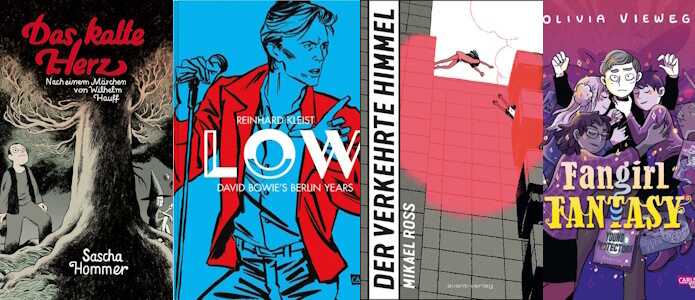Bookworld
Illustrated History of Germany‘s Past

The best German-language comics and graphic novels of 2024
by Ralph Trommer
This past year, the book market in Germany has been flooded with a wide variety of ambitious new publications by German comic artists. Graphic novels and comics are increasingly becoming a mainstay of the German literary scene and are steadily finding readers who turn to them as a source of information, entertainment and sophisticated storytelling. The spectrum ranges across all genres- from detective stories to literary adaptations, autobiographically inspired graphic novels to historical events narrated through eyewitness accounts.
In her graphic novel “Emmie Arbel: The Color of Memory” (Reprodukt Verlag), illustrator Barbara Yelin portrays a survivor of the Shoah. In order to illustrate her life, she met with her protagonist several times over three years, both in Germany and in Israel. Emmie Arbel, who is of Jewish descent, was born in The Hague in 1937, and had been deported by the Nazis in 1942, first to Ravensbrück and then to Bergen-Belsen. Her parents and grandparents were murdered in the camps, while she and her two brothers survived. After the war, she was raised by foster parents in the Netherlands, where she once again was exposed to violence. The extended family emigrated to Israel, but Emmie did not feel at home in the kibbutz either. Only as an adult did she manage to lead an independent life. At age 40, she was finally able to come to terms with her long repressed traumatic past. Since decades, she has been speaking about her experiences as a survivor and witness of history. Barbara Yelin tells her story in a relaxed, sketchy fashion, switching almost imperceptibly between the present and the narrated past so that Emmie Arbel’s fate moves us. The graphic novel has already won numerous awards, including the Gustav Heinemann Peace Prize for Children’s and Young Adult Books 2024 and the Max and Moritz Prize 2024: Special Jury Prize.
Maren Amini’s debut graphic novel “Ahmadjan and the Hoopoe” (Carlsen Verlag) introduces us to a fascinatingly different culture. She tells the life story of her Afghan-born father Ahmadjan, an artist whose paintings also appear in the book. Employing light brush strokes and colorful watercolors, Maren Amini details his childhood in Afghanistan, his arrival to West Germany in 1972, his path as an artist, his marriage to a German and how he was torn between cultures. The illustrator uses the 800-year-old Persian poem “Conference of the Birds” by Fariduddin Attar as an anchor for the content, which also lends the graphic novel a fairytale-like, poetic touch.

Olivia Vieweg’s works are easier to digest. In her latest graphic novel “Fangirl Fantasy” (Carlsen Verlag), she takes a humorous look at female fan cultures. She tells the story of the fictional British film actor Allan Dale, who is kidnapped one day by three female fans in the Thuringian forest. The three fans want to force him to play their favorite roles from various genres that he has long since abandoned... Olivia Vieweg, who was born inThuringia, succeeds in creating an amusing satire about the international film and television industry. The graphic novel is predominantly drawn in purple tones, while mixing the stylistic devices of European comics with Japanese manga.
In his latest graphic novel “The Upside Down Sky” (Avant Verlag), Mikael Ross also draws on elements from Manga comics, for example his characters’ facial expressions and his deliberate use of black and white. This time, he succeeds in creating a fast-paced, atmospheric crime thriller about three young adults who are drawn into a crime in Berlin-Lichtenberg: the murder of a Vietnamese woman by human traffickers. His action-packed story is based on true events. At the same time, it is a successful study of teenagers in schools located in the Lichtenberg district of Berlin, Vietnamese immigrants and of mutual respect.
“The Cold Heart” (Reprodukt Verlag) by Sascha Hommer creates a dense retelling of Wilhelm Hauff's romantic fairy tale about the naive coal burner Peter Munk, who sells his soul to end his poverty. The illustrator adds subtle touches to modernize the old German story, for example by turning the male protagonist into a woman. His atmospheric graphics vividly bring back to life a bygone era in a realistic yet also enchanting fashion. In Hommer’s adaptation, Hauff's fairy tale still functions today as a clever parable on greed in the era of early capitalism.
Reinhard Kleist has long been regarded as an exceptional graphic novelist in Germany. Biographies about musicians are among his favorite genres, as evidenced by his earlier novels on Nick Cave and Johnny Cash. “Low – David Bowie’s Berlin Years” (Carlsen Verlag) is the sequel to his graphic novel “Starman” (2021), which focused on Bowie’s early “Ziggy Stardust” years. This time around he centers on David Bowie‘s life in the then divided Berlin of the mid-1970s; encounters with Iggy Pop and Romy Haag and his collaborations with Brian Eno with whom he had created some of his most powerful albums. A multi-layered character study in garish colors that features Kleist‘s mastery as an illustrator and storyteller. The book succeeds in bringing the magic of Bowie’s music to people who are not yet familiar with his music.
Ralph Trommer, Graduate animator, freelance author and artist, regularly writes reviews and specialised articles on comics, graphic novels and films for various media.
Translated by Zaia Alexander
Copyright: © 2025 Litrix.de